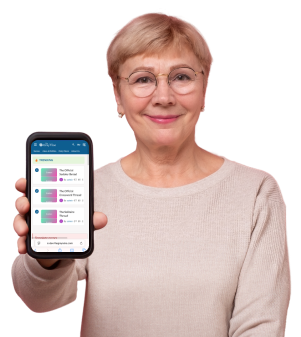Struggling with back pain? Here’s what actually works, according to experts
By
Veronica E.
- Replies 0
Disclaimer: The information provided in this article is for educational purposes only and is not intended as a substitute for professional medical advice, diagnosis, or treatment. Always consult your physician or other qualified healthcare providers with any questions you may have regarding a medical condition or before making any changes to your health regimen.
For many of us, back pain is more than just an occasional nuisance—it’s an unwelcome daily companion.
It can make even simple activities like getting out of bed or enjoying a walk more difficult.
Whether it’s a dull ache or sharp discomfort, finding real relief can feel like searching for a needle in a haystack.
With so many treatments available, how do you know which ones truly work?
Well, a major study has tackled this very question, and the results might surprise you.
Here at The GrayVine, we’re breaking it all down so you can make informed choices about managing your back pain.

Lower back pain is the most common type of pain among adults, affecting eight in ten Americans.
A comprehensive study from the University of New South Wales in Australia has uncovered a startling truth: only a handful of back pain treatments actually provide relief.
Researchers analyzed 301 trials covering 56 non-surgical treatments, and while many options exist, only a few showed proven effectiveness.
For chronic back pain, these methods offered some level of relief:
While these findings offer some direction, researchers emphasize the need for more high-quality studies to fully understand which treatments work best.
The study also debunked several popular methods, showing that some widely used treatments may not be as effective as we once thought.
For example, for acute back pain, the study found that exercise, acetaminophen (Tylenol), and corticosteroid injections likely provide little to no difference in pain levels.

Similarly, antibiotics and anesthetics were found ineffective for long-term lower back issues.
On the other hand, some treatments showed promise, even with lower certainty of effectiveness:
The Centers for Disease Control and Prevention (CDC) recommends a combination of ice, heat, rest, gentle movement, and over-the-counter pain relievers as the first line of defense against back pain.
The UK’s National Institute for Health and Care Excellence (NICE) also emphasizes that there’s no one-size-fits-all approach, and individuals should have access to a range of treatment options.
The study emphasizes that patients should have access to a broader range of treatments if initial methods prove ineffective.
Ash James, director of practice and development at the Chartered Society of Physiotherapy, stated, “Back pain is complex, with many contributing factors, so no single treatment will work for everyone, all the time.”
Back pain isn’t just about the spine—it’s influenced by multiple factors, including stress, lack of movement, poor sleep, obesity, smoking, and even fear of activity.
According to experts, working with a physiotherapist or healthcare provider can help pinpoint the root cause and tailor a treatment plan that best suits your individual needs.
If back pain is affecting your daily life, here’s how you can take charge:
Managing back pain can feel overwhelming, but understanding which treatments truly work can make all the difference.
While no single solution fits everyone, staying informed, exploring effective options, and maintaining a healthy lifestyle can help you find relief.
Read next: Stop drinking bottled water immediately! Scientists reveal surprising health risks you need to know

Living with back pain can be challenging, but you’re not alone. Have you found a treatment that worked for you? Or do you have questions about a particular remedy? Share your thoughts in the comments below!
For many of us, back pain is more than just an occasional nuisance—it’s an unwelcome daily companion.
It can make even simple activities like getting out of bed or enjoying a walk more difficult.
Whether it’s a dull ache or sharp discomfort, finding real relief can feel like searching for a needle in a haystack.
With so many treatments available, how do you know which ones truly work?
Well, a major study has tackled this very question, and the results might surprise you.
Here at The GrayVine, we’re breaking it all down so you can make informed choices about managing your back pain.

Understanding back pain: Exploring effective treatments for lasting relief. Image Source: Pexels / Kindel Media.
The surprising reality of back pain treatments
Lower back pain is the most common type of pain among adults, affecting eight in ten Americans.
A comprehensive study from the University of New South Wales in Australia has uncovered a startling truth: only a handful of back pain treatments actually provide relief.
Researchers analyzed 301 trials covering 56 non-surgical treatments, and while many options exist, only a few showed proven effectiveness.
For chronic back pain, these methods offered some level of relief:
- Non-steroidal anti-inflammatory drugs (NSAIDs) like ibuprofen for short-term relief.
- Exercise, which remains the most recommended long-term solution.
- Spinal manipulative therapy, often performed by chiropractors.
- Taping, which can help with posture and inflammation.
- Antidepressants, sometimes prescribed for nerve-related pain.
- Medications targeting TRPV1 pain receptors, which help block pain signals.
Also read: Physical therapist reveals the secret exercises to alleviate back pain instantly
The quest for effective back pain relief
While these findings offer some direction, researchers emphasize the need for more high-quality studies to fully understand which treatments work best.
The study also debunked several popular methods, showing that some widely used treatments may not be as effective as we once thought.
For example, for acute back pain, the study found that exercise, acetaminophen (Tylenol), and corticosteroid injections likely provide little to no difference in pain levels.

Acupuncture shows promise for back pain relief, though evidence remains limited. Image Source: Pexels / RDNE Stock project.
Similarly, antibiotics and anesthetics were found ineffective for long-term lower back issues.
On the other hand, some treatments showed promise, even with lower certainty of effectiveness:
- Acupuncture may offer moderate pain reduction.
- Massage therapy could lead to significant pain relief, although more research is needed.
Also read: Neurologist reveals 5 easy steps that cured her chronic back pain—Try them yourself!
The CDC’s recommendations and beyond
The Centers for Disease Control and Prevention (CDC) recommends a combination of ice, heat, rest, gentle movement, and over-the-counter pain relievers as the first line of defense against back pain.
The UK’s National Institute for Health and Care Excellence (NICE) also emphasizes that there’s no one-size-fits-all approach, and individuals should have access to a range of treatment options.
The study emphasizes that patients should have access to a broader range of treatments if initial methods prove ineffective.
Ash James, director of practice and development at the Chartered Society of Physiotherapy, stated, “Back pain is complex, with many contributing factors, so no single treatment will work for everyone, all the time.”
A personalized approach to back pain
Back pain isn’t just about the spine—it’s influenced by multiple factors, including stress, lack of movement, poor sleep, obesity, smoking, and even fear of activity.
According to experts, working with a physiotherapist or healthcare provider can help pinpoint the root cause and tailor a treatment plan that best suits your individual needs.
Also read: Is your lower back pain a sign of cancer? What you need to know!
Your action plan for back pain relief
If back pain is affecting your daily life, here’s how you can take charge:
- Consult with a healthcare professional to understand the underlying cause of your pain.
- Prioritize movement—exercise is one of the most effective ways to manage chronic pain.
- Consider proven treatments such as spinal manipulative therapy or NSAIDs for short-term relief.
- Explore complementary therapies like acupuncture or massage with an open mind, but be aware of the varying levels of evidence.
- Adopt a healthy lifestyle with regular activity, proper nutrition, and stress management to prevent pain from worsening.
Managing back pain can feel overwhelming, but understanding which treatments truly work can make all the difference.
While no single solution fits everyone, staying informed, exploring effective options, and maintaining a healthy lifestyle can help you find relief.
Read next: Stop drinking bottled water immediately! Scientists reveal surprising health risks you need to know
Key Takeaways
- Only a fraction of treatments for back pain are proven to be effective, according to a major study.
- For acute low back pain, non-steroidal anti-inflammatory drugs (NSAIDs) like ibuprofen show some efficacy, while for chronic back pain, effective treatments include exercise, spinal manipulative therapy, taping, antidepressants, and TRPV1-targeting drugs.
- The treatments confirmed to be effective only show small reductions in pain when compared to a placebo, and most treatments studied show inconclusive evidence, prompting a need for further research.
- The study suggests that treatments for back pain should be tailored to individual needs, as a one-size-fits-all approach does not work, and stresses the importance of considering various factors such as lifestyle and comorbidities.
Living with back pain can be challenging, but you’re not alone. Have you found a treatment that worked for you? Or do you have questions about a particular remedy? Share your thoughts in the comments below!






